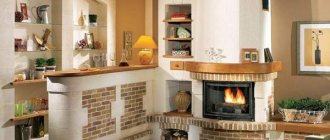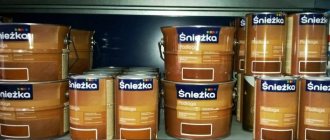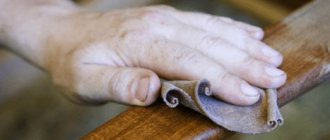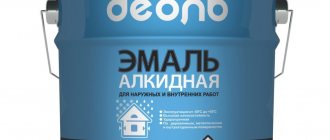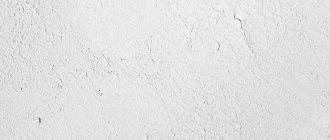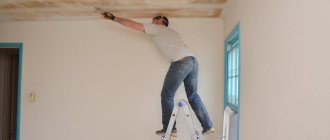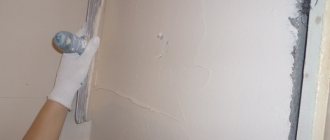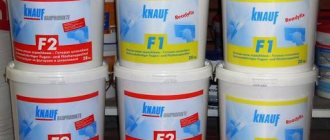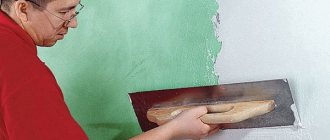13754 0 4
Andrey June 12, 2017 Specialization: facade finishing, interior finishing, construction of dachas, garages. Experience of an amateur gardener and gardener. We also have experience in repairing cars and motorcycles. Hobbies: playing the guitar and many other things that I don’t have time for :)
What is polyester putty with fiberglass, what properties and characteristics does it have? Since I often have to work with this material, I will answer these questions. In addition, I will tell you for what purposes this material can be used.
Polyester putty is a widely used material for leveling metal surfaces.
General information about the material
Fiberglass putty is a composition based on an unsaturated modified polyester resin, reinforced with special fibers and is a two-component product. In its original form, any polyester resin is quite hard, so various targeted additives are added to it to enhance ductility and elasticity. The fiberglass in the putty is intended to further enhance the strength of the material after drying.
What is the material
General information
Like any other putty, polyester compounds with fiberglass have a paste-like consistency. They are made on the basis of unsaturated modified polyesters.
These resins themselves are quite hard, therefore, to give them the necessary viscosity and plasticity, styrene is added to them. As you might guess, the fiberglass in these putties acts as a reinforcing filler. It increases the strength of the putty and improves some of its other properties, which we will discuss below.
Glass fiber increases the strength of the putty and prevents it from cracking
The solvent contained in polyester putties is very harmful to health. Therefore, when working with the composition in a closed space, it is necessary to take safety measures - wear a respirator and ensure the room is ventilated.
Polyester putties are sold as two-component formulations. Those. Before use, the putty must be mixed with a hardener.
Properties
Like any other building materials, the putty in question has its advantages and disadvantages. Below are its main positive and negative qualities.
Advantages:
- Possibility of application in a thick layer. The thickness of one layer can be 5-8 mm;
- No shrinkage. Even when applied in a thick layer, the coating practically does not shrink, unlike acrylic putty;
Fiberglass putty can be used to seal through holes.
- Does not crack. The fiberglass contained in the composition prevents cracking of the coating;
- Strength. Thanks to this, it is possible to use putty with fiberglass not only for sealing mother-in-laws and dents, but also through holes;
- Resistance to vibrations and vibrations. Due to this, this putty is widespread among motorists;
Due to its vibration resistance, polyester putty is often used for car repairs.
- Hardens quickly. The average drying time is about 20-30 minutes. As a rule, you can start sanding 15 minutes after applying the coating;
- Weather resistance. The material is not afraid of moisture, low temperatures, or ultraviolet radiation.
Flaws:
- Toxicity. As I said above, the solvent contained in the coating is harmful to health;
- Sets quickly . The composition is suitable for application in 4-8 minutes, so you need to work with it with your own hands quickly. This usually causes some problems for beginners.
Well-proven green putty with glass fiber Novol Fiber
Characteristics
As an example, consider the characteristics of the two-component Novol Fiber putty:
| Characteristics | Meaning |
| Minimum application temperature, ºС | 10 |
| Drying time at 20 ºС, min | No more than 30 |
| Maximum layer thickness, mm | 5 |
| Color | Green |
| Best before date | 24 months |
Putty composition
The main active substance of the putty is polyester resin - a viscous mass that is a little reminiscent of honey. It plays the role of a binding component and ensures the strength of the finished mixture. The composition also includes fiberglass particles that reinforce the mass and act as a filler. They increase the hardness of the coating after drying, so that it does not shrink and cracks do not appear.
Depending on the production technology, glass fiber threads are:
- Long. They are created in a continuous production process where molten glass is turned into thin streams and wound onto a drum. After hardening, the fibers pass through a special installation, where they are coated with an emulsion of starch, gelatin and plasticizers.
- Short. They are obtained by blowing liquid glass with steam or air. The finished fibers are short in length and resemble wool.
Fiberglass fiber
Most often, short reinforcing fibers are used in the production of putty. The material also contains styrene, which enhances elasticity. A hardener is sold in a separate package - this liquid substance, after mixing with the base, starts a chemical polymerization reaction, and the putty begins to harden.
Properties
Fiberglass putty is ideal for smoothing out various defects, chips, cracks and pits. It can be applied to products of a small or large area, and in the latter case a sprayer can be used to distribute it. There are special types of auto putties with reinforcing fibers for plastic - they have the highest quality of adhesion to this particular material.
Removing dents with fiberglass putty
The main properties of reinforced putties are as follows:
- vibration resistance;
- high strength;
- durability;
- short curing time;
- elasticity, stretchability;
- resistance to mechanical damage;
- Can be used on any hard surface.
Scope of application
The most common use of putty with fiberglass is for leveling metal surfaces, which is why motorists often use it. The polyester mixture is also widely used for the restoration of wooden objects. It has excellent contact with surfaces made of various materials, for example, concrete, wood, products with paint and varnish coating, natural stone, etc. Putties of this type should absolutely not be used as a coating for acid-curing soil, and they should not be used to putty objects made of thermoplastic or viscoelastic material.
Scope of application of putty
Most often, the material is used to seal small and medium-sized defects, for example, scratches and cracks, microchips. Some products are even suitable for sealing through and large holes in plastic and metal parts. The putty is ideal for working with all types of steel - galvanized, alloyed, galvanized, etc., as well as aluminum. It is no less suitable for processing products made of polyester laminate, fiberglass, and for old paint and varnish and primed coatings. In construction, the material is used when working with:
- concrete and cement;
- tree;
- natural stone;
- artificial stone.
After drying, polyester putties are coated with a layer of paint to further protect their surface. It is not recommended to apply car putties on substrates coated with etching and acid-curing primers, as well as on thermoplastic and viscoelastic (non-solid) materials.
Fiberglass putty
Hello everyone, I decided to write an article that will solve many disputes and questions. There is a very wide variety of putties on the market and it is very difficult for the average person to understand them, so I decided to tell you the principle of the design or composition of putties and the technology of use in car repair. Those who like to argue may, of course, disagree with me, but basically this is not my data, but materials from one of the largest manufacturers of putties, the VOSSCHEMIE concern.
For lovers of literature who start poking at the spelling of words: putty, putty, and so on, I suggest you follow the link and calm down - the spellings shpaKlyok and shpATlyovka are correct in both cases
Of course, the Russian market lags far behind the European and world ones, but in principle, with the materials that are on sale, following the repair technology, you can make high-quality repairs, without having to buy “magic materials” for fabulous money.
Putties began to be widely used in the late 50s. At that time, body parts were not produced by forging on presses, as is the case now, but were made entirely by hand, and therefore each part had its own original shape and size, and therefore low-melting solders were used to fill dents and level surfaces. First, the part was straightened using a hammer and a backing stamp (remember, body panels used to be much thicker), then the damage was filled with solder brought to a liquid state with a gas burner, and the final adjustment to the shape was performed with special files.
This process is painstaking, low-tech and lengthy, which is absolutely not in the spirit of our time. In addition, anti-corrosion protection today raises requirements to a completely different level, and work using tinning technology does not allow the metal to be fully protected. In addition, working with open flames and molten solder in a workshop full of tin dust and acid fumes is unsafe for the health of workers. And if in the 50s they did not pay much attention to this, in our time the requirements for safety and labor protection have become more stringent. Today, parts are produced in stamps and the dimensions and shape of the parts are always ideal, therefore the technology of fusion repair has sunk into oblivion and it is not surprising that a paste-like product, which can be quickly and easily mixed, applied and molded without heating or special equipment, very soon gained popularity...
WHAT IS PUTTY?
Based on GOST 28246-89, which establishes paint and varnish terminology: Putty is a product of paste or liquid consistency used to eliminate minor surface defects before painting. Any putty consists of a mixture of fillers with pigments (the former are responsible for filling properties, strength, ease of processing, degree of shrinkage, elasticity, the latter - for color) in a binder (responsible for adhesion to the surface, polymerization rate, the same degree of shrinkage, strength and elasticity) with various additives (plasticizers, stabilizers, etc.). Nowadays, polyester putties (PE) have become overwhelmingly widespread in the repair of automobile bodies (based on the chemical basis of the binder). Compared to putties based on acrylic and nitro bases, polyester ones have the least shrinkage (with a relatively large thickness of the applied layer) and the highest polymerization rate. However, many craftsmen are not even aware of the existence of other putties - the popularity of polyester putties is so great today. Although today putties based on epoxy resins are already used, which makes them more useful in terms of anti-corrosion protection.
TYPES OF POLYESTER PUTTY
As a process, surface leveling consists of two stages: filling and finishing.
First, preliminary leveling is performed, “filling up” deep irregularities, to create a plane from which the final shape will be restored, after which the final finishing of the surface is performed. According to this principle, all putties are divided into two large groups: filling; finishing One thing is clear: filling putties quickly fill deep unevenness. However, most often, such putties have a coarse-grained structure and are not capable of creating a smooth, non-porous surface (for example, fiberglass putty), therefore they require the subsequent application of finishing putties. Lapping putties are fine-grained materials. They are flexible, easy to apply and easy to sand. On the one hand, they are used as finishing after coarse-grained putties, on the other hand, as an independent unit for eliminating minor defects. There are also universal putties that have the properties of both filling and finishing at the same time. Different materials are also used for application to metal and plastic. According to the method of application, putties can be highly viscous, applied with a spatula, and liquid - “under a gun” (they also go under a brush or roller). To understand which putty is best used for which types of work, let’s take a closer look at the properties of the main types of putty masses offered by leading manufacturers of repair materials.
HIGH-FILLING, REINFORCED WITH FIBER GLASS, CARBON OR KEVLAR (GLASS, FIBER, FIBRE, Carbon, etc.)
If it is necessary to restore a heavily deformed part, and usually this is a part that comes from body repair or, so to speak, after straightening, then use putty reinforced with fiberglass or other reinforcing elements. Additives of short chopped fiberglass provide this putty with high strength and reinforcing characteristics, as well as high filling capacity - this putty can be applied in fairly thick layers, quickly eliminating even very deep unevenness. The same putty, but with a long fiber, is used in cases of sealing various through damage to a part, places where metal is torn. Glass fibers here play the role of a kind of bridges, reinforcing and preventing the material from falling over empty spaces. Many craftsmen completely misinterpret this putty as low-quality and so on; in fact, this is one of the main putties for repairs. The main advantage of this putty is its low shrinkage; compared to other types of putty, it has practically no shrinkage, at least it is very rare. Among other advantages, we can note the longer life of this putty compared to others - up to 8 minutes (the rest up to 5 minutes), which plays into the hands when working on large surfaces and the quality of putty.
Modern putty with fiberglass, virtually no shrinkage.
Advantages and disadvantages
Putty based on reinforcing glass fibers and polyester resin has a lot of undoubted advantages:
- possibility of application in a fairly thick layer;
- no shrinkage after drying even with thick-layer application;
- no cracking during operation;
- strength, ability to be used to repair complex damage;
- resistance to vibrations and vibrations of surfaces, which only increases its popularity among auto repair specialists;
- rapid hardening, initial setting within 20-30 minutes;
- possibility of grinding on the first day;
- resistance to atmospheric factors;
- moisture resistance, no damage due to temperature changes, exposure to ultraviolet radiation.
Application in a thick layer is allowed.
The disadvantages of car putty include its toxicity, because the composition contains a very harmful solvent - styrene, which has a negative effect on the human body. You need to work with the product quickly, literally within 5-8 minutes, otherwise it will become viscous and will not be leveled properly.
Beginners often encounter difficulties regarding the speed of applying the composition, so they will have to practice on a rough surface in advance. Experience is also needed to give the composition the desired shape, especially when filling through holes and chips of complex configuration.
Flaws
- The product is toxic. As mentioned earlier, the solvent in the composition of polyester putty has a negative effect on the human body.
- Fast hardening. The composition must be used within 4-8 minutes. after its preparation. Consequently, the work must be done very quickly, which, as a rule, beginners have some problems associated with this.
Putty with green fiberglass from the Novol Fiber brand leaves a good impression.
Tools and materials for work
Before diluting the mixture, you need to make sure that you have all the necessary tools and consumables:
- a set of spatulas made of metal, rubber, plastic (it will be more convenient to choose the appropriate one in each specific case);
- sandpaper with grain size 60-240;
- rags or sponges;
- block for securing sandpaper;
- solvent for degreasing the base;
- special spray or powder composition to reveal defects;
- soil suitable for the base material;
- compressed air cylinder.
When selecting a spatula, it is necessary to take into account that a tool with a metal blade is more suitable for working with fairly smooth surfaces where there are defects of minor depth.
Spatulas made of rubber and plastic are used mainly for processing round, curved areas and corners. It is recommended to buy high-quality tools, since cheap ones often have nicks and leave micro-scratches, and also break quickly.
Polyester putty. Preparing and mixing putty
You can prepare the putty on a piece of organic glass or purchase a special “easel” for mixing the putty. Basically, many people use two spatulas, one large and the other smaller. Clean the tool immediately after finishing work, before the residue has hardened. After the putty has cured, it is necessary to sand the surface to remove the smallest irregularities. The spatula can also be cleaned with a universal solvent.
During putty storage, solid particles settle and the resin forms a film. Therefore, before use, it should be thoroughly mixed to ensure uniform mixing of the resin and solid filler. Otherwise, it is impossible to achieve the desired ratio when adding a hardener, since the filler will not participate in the reaction. To remove the putty from the container, use only a clean tool. Any putty or hardener left on the tool will react with the contents of the container, causing the remaining putty to become unusable.
The putty is applied to the surface using spatulas. Stores sell special sets of spatulas, made of thin steel or stainless steel. There are also plastic and rubber spatulas, which are very convenient to use in certain situations. To putty large and flat areas, such as door panels, you can use a construction façade spatula for finishing work, and it is also suitable as a ruler for controlling the shape of the sanded surface.
Polyester putty consists of two components that must be mixed immediately before use: resin and hardener (catalyst). The hardener should be added in the proportion specified by the manufacturer; usually from 2 to 3 g per 100 g of putty (2...3 percent by weight). The putty and red hardener should be mixed with a spatula until no traces of red hardener are visible. The ability to correctly dose hardener comes with experience.
“Putty” should be applied thinly. With a thick layer, it is impossible to obtain a high-quality coating.
The prepared automotive putty should be used within 5 to 10 minutes. The putty layer should be applied quickly and accurately. Do not mix putties more than required. It loses the qualities necessary to obtain a high-quality layer.
- Too little hardener (catalyst). The putty does not cure in the required time. Sanding is difficult, it gets into lumps, scratches and risks occur.
- Too much hardener (catalyst). This “putty” does not harden faster. The active hardener remains in it, which reacts with the resin and pigments of the filler and paint. The result is defects: uneven coloring, the formation of spots and obvious contours of painted areas.
Preparatory stage
It is best to apply the material to clean metal, but if necessary, you can even work on old paint or varnish. Peeling, crumbling coatings are removed using a metal spatula or power tools. Areas affected by rust are sanded, completely eliminating the spots. Narrow cracks are widened slightly to make it easier to seal them with putty. Then, in relation to the working surface, do the following:
- processed with sandpaper for matting;
- clean from dust with compressed air, wipe with solvent;
- allow to dry completely.
Preparation of the composition
Before combining the base with the hardener, you need to thoroughly mix the main component, and then familiarize yourself with the mixing proportions indicated by the manufacturer. For measuring, you can use ordinary electronic scales, but it is important that they do not have a large operating error. The serving size should be such that it is completely consumed within a few minutes.
After combining the two components, the putty is kneaded well until a homogeneous mass is obtained, uniform in thickness and shade. If the solution remains poorly mixed, or the amount of hardener is small or too large, the putty will harden unevenly. Also, the material may completely peel off from the substrate.
Applying putty
When working with fiberglass-based compounds, you must first prime the surface, then putty, and finally sand the coating.
Padding
Preferably highly porous wooden and concrete surfaces should be primed. The metal can be left uncoated with primer.
Puttying
Apply the finished mixture with a spatula and immediately level it, trying to get as smooth a surface as possible. At the same time, make sure that the layer thickness does not exceed the permissible one, but is not too small. Wait until the putty has completely hardened, then, if necessary, apply a second layer of the product. If necessary, use the powder for its intended purpose to reveal defects.
Grinding
This stage is required to perfectly level the coating and eliminate even the smallest flaws. First, they go over the putty layer with sandpaper with a coarser grain, then process it with fine-grained paper (for example, P120). Next, prime the putty product, having first brushed off the dust. Then you can apply a layer of finishing putty or immediately paint the part.
Popular manufacturers
On sale you can find car putties with fiberglass from the following popular manufacturers:
- A two-component product for filling holes in car bodies and for sealing defects in other metal structures. Has high adhesion to metals and is moisture resistant. The maximum layer thickness is 3 mm.
- Sea-Line. Reinforced polyester putty for strengthening and repairing plastic fiberglass and metal substrates, as well as to prevent the spread of corrosion. Cures within 30 minutes at room temperature.
- Easy to apply and easy to sand. It begins to set 5-10 minutes after dilution. With infrared drying it dries in 5 minutes, naturally - in 20 minutes. Suitable for steel, aluminum, plastic.
Polyester putty Sea Line
Auto putty with reinforcing fiberglass is an excellent composition option for repairing damage to the bumper, body or other parts of the car. This material is reliable, durable and allows you to restore the appearance of your car without the involvement of specialists.
